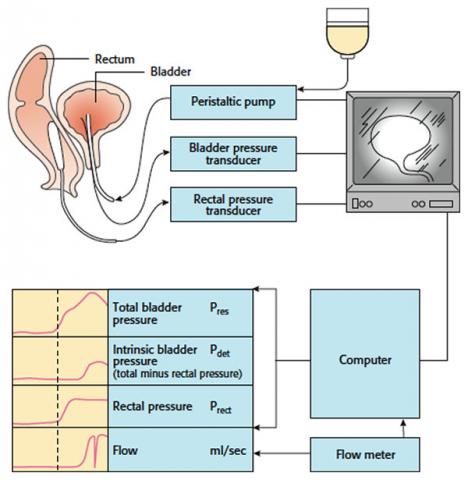What is it?

Urodynamics is an outpatient study that evaluates the function of the bladder. If done in conjunction with imaging (X-ray or ultrasound), it can also identify structural abnormalities. This test is not painful and is done with the patient awake, so that the patient can follow instructions and give feedback during the study. Urodynamics is an important investigation in identifying the cause of complex bladder problems.
Why is it done?
Indications for this study:
-
If the diagnosis is unclear after history and examination.
-
Confirm diagnosis before initiation of medical treatment.
-
Confirm diagnosis before surgical or invasive treatments.
-
The failure of initial therapy.
-
Provide guidance as to the desired outcome or option before treatment.
-
Clinical follow-up (e.g. neuropathic bladder).
How is it done?
The study normally takes about 45 minutes. After an initially emptying the bladder, a small catheter (pressure line) is inserted into the bladder and another one into the rectum. These lines are connected to a computer and they detect the pressures in the bladder with high accuracy.
There are two phases to this test:
-
The filling phase
-
The voiding phase
Filling phase
During the filling phase, a sterile fluid is trickled into your bladder. You will be asked to report on the sensations and degree of urgency as your bladder is filled. You should do your best to hold the fluid in.
This phase will test for:
-
Your bladder sensation.
-
The pressure in your bladder as it stretches.
-
Overactivity of the bladder.
-
Leakage from the bladder due to irresistible urge.
-
Your estimated bladder capacity.
-
You may be asked to do a series of cough, stand or bear down to test for stress leakage.
X-ray or ultrasound can look for:
-
Shape of the bladder.
-
Reflux of urine up the ureters and kidneys.
Voiding phase
During the voiding phase, you will be asked to do a ‘normal’ void. This phase will test for:
-
How well your bladder can contract
-
Bladder outlet obstruction (e.g. from an enlarged prostate)
-
X-rays or ultrasound can look for:
-
The degree of bladder neck support during voiding (important in patients with stress incontinence).
-
How well the bladder neck opens up during voiding.
-
How much urine is left behind after a passing urine.
The small catheters are then removed at the end of the study.
How do I prepare for it?
-
Before the study, you may be asked to complete a bladder diary or a questionnaire.
-
You should arrive with a comfortably full bladder, so that we can start with measurements of a first void.
-
Your doctor may ask you to either continue or discontinue some of your bladder medications in the lead-up to this study.
-
You do not need to fast before the test. You can resume all normal activities, including driving after the study.
-
If you suspect you have a urinary tract infection, this test should be postponed.
